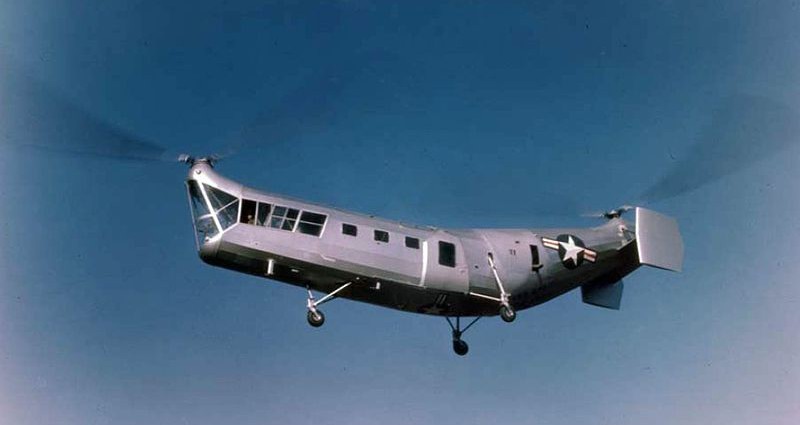| Picture |

|
| Manufacturer |
Piasecki
|
| Type |
HRP-1 / PV-3
|
| Introduced |
6/1/1947
|
| In production? |
No
|
| Units produced |
20
|
| Price US $ |
0.00
|
| Overall Length |
0 ft
|
| Length |
47.1 ft
|
| Height |
14.9 ft
|
| Width |
0 ft
|
| |
|
| |
|
| Description |
A product of the famous helicopter designer Frank Piasecki, the HRP-1 Rescuer (aka the PV-3, Harp and “Flying Banana”) was a tandem-rotor helicopter with significant historical significance. In March of 1945 the first prototype PV-3 took flight in Morton, Pennsylvania. Known to the team as the “Dogship”, the PV-3 prototype was the result of a contract with the United States Navy, closed merely a year before. The prototype suffered many mechanical failures, which brought about the realization that automotive components could not stand up to the stresses of flight and kick-started the idea that helicopters should have components specially designed for their own purposes.The first production models were introduced in 1947, which means that the HRP-1 had a remarkably short development time.The distinctive banana shape of the PV-3 was a measure to ensure that the rotor blades could not run afoul of each other. The fuselage was made from mild steel tubing, filled with wooden ribs and covered with doped fabric. The HRP-1 production model was powered by a Pratt & Whitney R-1340-AN-1 radial engine that produced 600 horsepower (about 447kW).The main role of the HRP-1 was as a utility transport and rescue aircraft. The HRP-1 was the first helicopter in military service that was capable of significantly usable transport ability. It was therefore put to work moving cargo and personnel. The HRP-1 could move eight passengers or six stretchers. It’s payload capacity was a total of 2 000 lb (about 907kg), making it the most capacious vertical takeoff vehicle in the US at the time.Unfortunately, the HRP-1 suffered constant mechanical issues while in service. Overall however, the HRP-1 was successful enough to lead to a successor in the form of the H-21 family of helicopters.In total 28 helicopters were built. Of these 20 were HRP-1 production models. Twelve of these went to the Marine Corps for assault training. Three were used as rescue aircraft and designated HRP-1G. After service ended six HRP-1 helicopters made it into the civilian fleet.
|
| Advertisement |
|
| Design features |
- Tandem rotor configuration
|
|
A product of the famous helicopter designer Frank Piasecki, the HRP-1 Rescuer (aka the PV-3, Harp and “Flying Banana”) was a tandem-rotor helicopter with significant historical significance. In March of 1945 the first prototype PV-3 took flight in Morton, Pennsylvania. Known to the team as the “Dogship”, the PV-3 prototype was the result of a contract with the United States Navy, closed merely a year before. The prototype suffered many mechanical failures, which brought about the realization that automotive components could not stand up to the stresses of flight and kick-started the idea that helicopters should have components specially designed for their own purposes.The first production models were introduced in 1947, which means that the HRP-1 had a remarkably short development time.The distinctive banana shape of the PV-3 was a measure to ensure that the rotor blades could not run afoul of each other. The fuselage was made from mild steel tubing, filled with wooden ribs and covered with doped fabric. The HRP-1 production model was powered by a Pratt & Whitney R-1340-AN-1 radial engine that produced 600 horsepower (about 447kW).The main role of the HRP-1 was as a utility transport and rescue aircraft. The HRP-1 was the first helicopter in military service that was capable of significantly usable transport ability. It was therefore put to work moving cargo and personnel. The HRP-1 could move eight passengers or six stretchers. It’s payload capacity was a total of 2 000 lb (about 907kg), making it the most capacious vertical takeoff vehicle in the US at the time.Unfortunately, the HRP-1 suffered constant mechanical issues while in service. Overall however, the HRP-1 was successful enough to lead to a successor in the form of the H-21 family of helicopters.In total 28 helicopters were built. Of these 20 were HRP-1 production models. Twelve of these went to the Marine Corps for assault training. Three were used as rescue aircraft and designated HRP-1G. After service ended six HRP-1 helicopters made it into the civilian fleet.
|
|
- Advertisement -
|
Design features:
- Tandem rotor configuration
|
| Persons |
10
|
| Max. Range |
140 mi
|
| Cruise Speed |
74 mph
|
| Max. Speed |
98 mph
|
| Max. rate of Climb |
650 ft/min
|
| HOGE ceiling |
0 ft
|
| Service Ceiling |
10400 ft
|
| Gross Weight |
6900 lb
|
| Empty Weigt |
5200 lb
|
| Useful Load |
1700 lb
|
| Fuel Capacity |
100 gallons
|
| Number of Engines |
1
|
| Engine Type |
Piston
|
| Engine Code |
Pratt & Whitney R-1340-AN
|
| Horse Power |
600
|
| Rotorhead |
Tandem
|
| Number of rotorblades |
3
|
| Rotor Diameter |
41 ft
|
| Number of tail rotorblades |
3
|
| Tailrotor Diameter |
41 ft
|
|